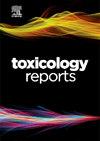血清葡萄糖/钾比值在评估急性磷化铝中毒患者中毒严重程度和不良结局中的作用
Q1 Environmental Science
引用次数: 0
摘要
磷化铝(ALP)中毒是一个重要的健康问题,因为它容易获得,极具效力,并没有特定的治疗方式。本研究旨在评估葡萄糖/钾(Glu-K)比值在预测急性ALP中毒的严重程度和不良结局中的作用。目前的回顾性队列研究涉及2022年6月至2024年6月在坦塔大学中毒控制中心入院的急性ALP中毒患者。记录了社会人口学和中毒数据、临床检查的初步结果、gluk比率、中毒严重程度评分(PSS)、急性生理和慢性健康评估II (APACHE II)和PGI评分的计算。根据死亡结果将患者分为两组。在206例急性alp中毒患者中,我们记录了67.5% %的死亡率。非幸存者的Glu-K比值中值显著高于幸存者(44.8 vs 28.9;p & lt; 0.001)。Glu-K与PSS、APACHE II和PGI评分呈正相关(p <; 0.001)。APACHE II评分在预测死亡率和机械通气需求方面表现出最高的性能(AUC分别为0.876和0.853)。然而,与其他评分系统(PSS和PGI)相比,Glu-K比率在预测所有不利结果方面具有相当的歧视性。Glu-K比值≥ 37.07的患者生存时间明显低于Glu-K比值≥lt 37.07的患者(0.38 vs 3天;p & lt; 0.001)。因此,初始Glu-K比值是一种容易获得的常规生物标志物,用于评估alp中毒患者的中毒严重程度和结局概率,特别是在医疗设施有限的情况下。本文章由计算机程序翻译,如有差异,请以英文原文为准。
Role of serum glucose/potassium ratio in assessing poisoning severity and adverse outcomes in patients with acute aluminum phosphide poisoning
Aluminum phosphide (ALP) poisoning is a crucial health problem owing to its easy availability, extreme potency, and absence of specific treatment modalities. This study aimed to assess the role of the glucose/potassium (Glu-K) ratio in predicting the severity and adverse outcomes of acute ALP poisoning. The current retrospective cohort study involved patients with acute ALP poisoning who were admitted to Tanta University Poison Control Center from June 2022 to June 2024. Sociodemographic and poisoning data, initial findings of clinical examination, Glu-K ratio, and calculation of Poisoning Severity Score (PSS), Acute Physiology and Chronic Health Evaluation II (APACHE II), and PGI score were documented. Patients were categorized into two groups according to mortality outcome. Out of 206 acute ALP-poisoned patients, we recorded 67.5 % fatalities. The median value of the Glu-K ratio was significantly higher in nonsurvivors than in survivors (44.8 versus 28.9; p < 0.001). The Glu-K positively correlated with PSS, APACHE II, and PGI scores (p < 0.001). The APACHE II score exhibited the highest performance for predicting mortality and the need for mechanical ventilation (AUC=0.876 and 0.853, respectively). However, the Glu-K ratio conveyed a comparable discriminatory power with other scoring systems (PSS and PGI) for anticipating all unfavorable outcomes. Patients with a Glu-K ratio ≥ 37.07 had significantly decreased survival duration than patients with a Glu-K ratio < 37.07 (0.38 versus 3 days; p < 0.001). Therefore, the initial Glu-K ratio is an easily accessible routine biomarker for assessing poisoning severity and outcomes probability of ALP-poisoned patients, particularly with limited healthcare facilities.
求助全文
通过发布文献求助,成功后即可免费获取论文全文。
去求助
来源期刊

Toxicology Reports
Environmental Science-Health, Toxicology and Mutagenesis
CiteScore
7.60
自引率
0.00%
发文量
228
审稿时长
11 weeks
 求助内容:
求助内容: 应助结果提醒方式:
应助结果提醒方式:


